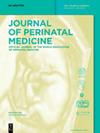Current obstetric outcomes in Jamaican women with sickle hemoglobinopathy – a balance of risks for aspirin?
IF 1.7
4区 医学
Q3 OBSTETRICS & GYNECOLOGY
引用次数: 0
Abstract
Objectives Sickle cell disease (SCD) occurs in 2.8 % of our Jamaican antenatal population with homozygous HbSS being most associated with adverse maternal and perinatal outcomes. Methods A retrospective comparative analysis of HbSS, HbSC and HbSβThal pregnancy outcomes at the University Hospital of the West Indies (UHWI) between January 2012 and December 2022 was conducted. Results Of 120 patients (138 pregnancies), obesity occurred in 36 % (20/56) of the ‘non-HbSS’ group, i.e. HbSβThal (55 %, 5/9) and HbSC (32 %, 15/47) combined vs. 9.7 % of the HbSS (8/82). HbSS patients had more crises requiring transfusions, acute chest syndrome (ACS), maternal ‘near-misses’ (OR=10.7, 95 % 3.5–32.3; p<0.001), hospitalizations (OR 7.6, 95 % CI 3.4–16.9; p<0.001), low birth weight (LBW) neonates (OR 3.1, 1.1–8.9; p=0.037) and preterm birth (OR=2.6, 1.2–5.8; p=0.018) compared to HbSC and HbSβThal. Low dose aspirin was prescribed in 43 %. Logistic regression showed those NOT on aspirin (n=76) had more miscarriages (22 v. 2 %), were LESS likely to have a live birth (75 v. 95 % (0.2, 0.04–0.57, p=0.005)), but surprisingly had fewer painful crises (28 v. 46 % (0.5, 0.03–0.9, p=0.03)). Conclusions HbSS women had a 10-fold excess of maternal near-misses. Additional research may further clarify the effects of aspirin on pregnancy outcomes as related to SCD genotypes.患有镰状血红蛋白病的牙买加妇女目前的产科结果--阿司匹林的风险平衡?
目的 镰状细胞病(SCD)在牙买加产前人群中的发病率为 2.8%,其中同型 HbSS 与不良的孕产妇和围产期结局关系最为密切。方法 对 2012 年 1 月至 2022 年 12 月期间西印度群岛大学医院(UHWI)的 HbSS、HbSC 和 HbSβThal 妊娠结局进行回顾性比较分析。结果 在 120 名患者(138 次妊娠)中,"非 HbSS "组(即 HbSβThal(55%,5/9)和 HbSC(32%,15/47))中有 36% (20/56)发生肥胖,而 HbSS 组(8/82)为 9.7%。HbSS 患者有更多需要输血的危机、急性胸部综合征(ACS)、产妇 "险些死亡"(OR=10.7,95 % 3.5-32.3;p<0.001)、住院(OR 7.6,95 % CI 3.4-16.9;p<0.001)、低出生体重(LBW)新生儿(OR 3.1,1.1-8.9;p=0.037)和早产(OR=2.6,1.2-5.8;p=0.018)。43%的孕妇服用了小剂量阿司匹林。逻辑回归结果显示,未服用阿司匹林的患者(n=76)流产率更高(22% 对 2%),活产率更低(75% 对 95% (0.2, 0.04-0.57, p=0.005)),但令人惊讶的是,痛性危机更少(28% 对 46% (0.5, 0.03-0.9, p=0.03))。结论 HbSS 妇女的孕产妇险情发生率高出 10 倍。其他研究可能会进一步阐明阿司匹林对妊娠结局的影响与 SCD 基因型的关系。
本文章由计算机程序翻译,如有差异,请以英文原文为准。
求助全文
约1分钟内获得全文
求助全文
来源期刊

Journal of Perinatal Medicine
医学-妇产科学
CiteScore
4.40
自引率
8.30%
发文量
183
审稿时长
4-8 weeks
期刊介绍:
The Journal of Perinatal Medicine (JPM) is a truly international forum covering the entire field of perinatal medicine. It is an essential news source for all those obstetricians, neonatologists, perinatologists and allied health professionals who wish to keep abreast of progress in perinatal and related research. Ahead-of-print publishing ensures fastest possible knowledge transfer. The Journal provides statements on themes of topical interest as well as information and different views on controversial topics. It also informs about the academic, organisational and political aims and objectives of the World Association of Perinatal Medicine.
 求助内容:
求助内容: 应助结果提醒方式:
应助结果提醒方式:


